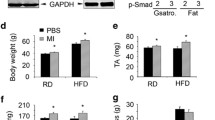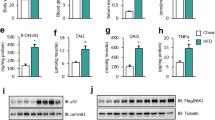Abstract
Suppression of myostatin (MSTN) is associated with skeletal muscle atrophy and insulin resistance. However, the mechanisms by which MSTN regulates insulin resistance are not well known. We have explored the signaling pathways through which MSTN regulates insulin resistance in diet-induced obese rats using a polyclonal antibody for MSTN. The anti-MSTN polyclonal antibody significantly improved insulin resistance and whole-body insulin sensitivity, decreased MSTN protein expression in muscle samples by 39 % in diet-induced obese rats. Furthermore, the anti-MSTN polyclonal antibody significantly enhanced PI3K activity (140 %), Akt phosphorylation (86 %), GLUT4 protein expression (23 %), the phosphorylation of mTOR (21 %), and inhibited the phosphorylation of FoxO1 (57 %), but did not affect the phosphorylation of GSK-3β. Thus, suppression of MSTN by the anti-MSTN polyclonal antibody reverses insulin resistance of diet-induced obesity via MSTN/PI3K/Akt/mTOR and MSTN/PI3K/Akt/FoxO1 signaling pathways.





Similar content being viewed by others
References
Guo T, Jou W, Chanturiya T, Portas J, Gavrilova O, McPherron AC (2009) Myostatin inhibition in muscle, but not adipose tissue, decreases fat mass and improves insulin sensitivity. PLoS ONE 4:e4937
Hittel D, Axelson M, Sarna N, Shearer J, Huffman K, Kraus W (2010) Myostatin decreases with aerobic exercise and associates with insulin resistance. Med Sci Sport Exerc 42:2023–2029
Kadowaki T, Hara K, Yamauchi T, Terauchi Y, Tobe K, Nagai R (2003) Molecular mechanism of insulin resistance and obesity. Exp Biol Med 228:1111–1117
Knowler WC, Barrett-Connor E, Fowler SE, Hamman RF, Lachin JM, Walker EA, Nathan DM (2002) Reduction in the incidence of type 2 diabetes with lifestyle intervention or metformin. New Engl J Med 346:393–403
Kopelman PG (2000) Obesity as a medical problem. Nature 404:635–643
Léger B, Cartoni R, Praz M, Lamon S, Dériaz O, Crettenand A, Gobelet C, Rohmer P, Konzelmann M, Luthi F (2006) Akt signalling through GSK-3β, mTOR and Foxo1 is involved in human skeletal muscle hypertrophy and atrophy. J Physiol 576:923–933
Marchitelli C, Savarese MC, Crisà A, Nardone A, Marsan PA, Valentini A (2003) Double muscling in Marchigiana beef breed is caused by a stop codon in the third exon of myostatin gene. Mamm Genome 14:392–395
McPherron AC, Lawler AM, Lee SJ (1997) Regulation of skeletal muscle mass in mice by a new TGF- ß superfamily member. Nature 387:83–90
Pallafacchina G, Calabria E, Serrano AL, Kalhovde JM, Schiaffino S (2002) A protein kinase B-dependent and rapamycin-sensitive pathway controls skeletal muscle growth but not fiber type specification. Proc Natl Acad Sci USA 99:9213–9218
Schuelke M, Wagner KR, Stolz LE, Hübner C, Riebel T, Kömen W, Braun T, Tobin JF, Lee S-J (2004) Myostatin mutation associated with gross muscle hypertrophy in a child. N Engl J Med 350:2682–2688
Srinivasan K, Patole P, Kaul C, Ramarao P (2004) Reversal of glucose intolerance by pioglitazone in high fat diet-fed rats. Methods Find Exp Clin Pharmacol 26:327–333
Tang L, Yan Z, Wan Y, Han W, Zhang Y (2007) Myostatin DNA vaccine increases skeletal muscle mass and endurance in mice. Muscle Nerve 36:342–348
van der Horst A, Burgering BM (2007) Stressing the role of FoxO proteins in lifespan and disease. Nat Rev Mol Cell Biol 8:440–450
Zhao B, Wall RJ, Yang J (2005) Transgenic expression of myostatin propeptide prevents diet-induced obesity and insulin resistance. Biochem Biophys Res Commun 337:248–255
Acknowledgments
This work was supported by the National Science Fund for Outstanding Young Investigators (30900710), the Natural Science Foundation of Shaanxi Province, China (2012JM3011), the Innovation Funds of Graduate Programs, SNNU (2012CXS036), and the Fundamental Research Funds for the Central Universities (GK201302042 and GK201402045). We would like to thank all the members of our laboratory for their encouragement and help with this study.
Conflicts of interest
The authors declare that they have no conflicts of interest.
Author information
Authors and Affiliations
Corresponding author
Electronic supplementary material
Below is the link to the electronic supplementary material.
Rights and permissions
About this article
Cite this article
Tang, L., Liu, Ct., Wang, Xd. et al. A prepared anti-MSTN polyclonal antibody reverses insulin resistance of diet-induced obese rats via regulation of PI3K/Akt/mTOR&FoxO1 signal pathways. Biotechnol Lett 36, 2417–2423 (2014). https://doi.org/10.1007/s10529-014-1617-z
Received:
Accepted:
Published:
Issue Date:
DOI: https://doi.org/10.1007/s10529-014-1617-z




